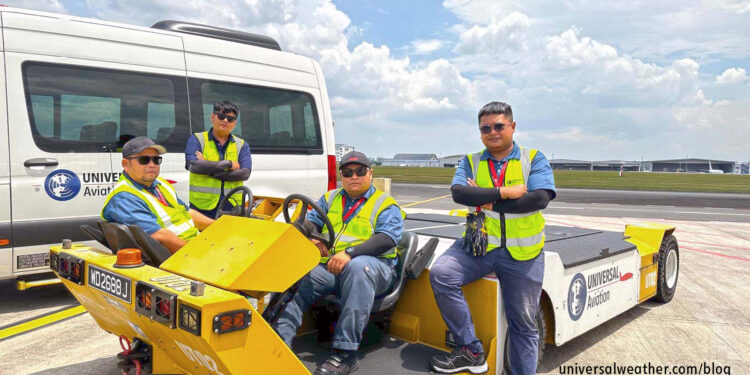FAQs on Arranging Ground Handling in Singapore

This is a post by author Yvonne Chan. Yvonne is Managing Director for Universal Aviation Singapore, which has an aircraft ground-handling facility in Seletar. Yvonne is an expert on business aircraft operations in Singapore and can be contacted at yvonnechan@universalaviation.aero.
This business aviation blog post is part of a series on operating in Singapore and continues from our last article: “Airport Operations and CIQ Considerations for Singapore.”
Singapore offers full services, good handling, and relatively easy general aviation (GA) access. The two airports available to GA differ in terms of access requirements, costs, and operational flexibility. It’s best to coordinate with your 3rd-party provider in advance to select the airfield that best suits your needs.
1. How many airport options are available for Singapore?
Changi (WSSS) and Seletar (WSSL) are available for GA, while access to Paya Lebar (WSAP) is restricted to head of state flights only with permission required from the Singapore Foreign Affairs department. Ground handlers cannot assist with operations into WSAP.
2. Are there operating curfews to consider?
WSSL closes its runway 0001-0700 local on the first Saturday of every month (or the second Saturday if the first Saturday is a public holiday). Also, every Wednesday and Saturday between 0001-0200 local, the WSSL runway is closed to all traffic. During both of these closures, the runway is closed to all traffic except medevac and emergency flights. Advance notice of 30 minutes is required for emergency opening of the runway.
3. What information is required to arrange ground handling?
Your ground handler will need 24 hours’ notice and full details of the itinerary (arrival and departure), type of aircraft, registration, operator name, type of operation, mode of payment, crew and passenger details, and services required. Airport slots are necessary for WSSS, so the itinerary will be used to request them. Also, please note that Stage 2 aircraft are banned in Singapore. Your ground handler will require nationality information to determine if visas are required. Visas must be arranged in advance.
4. Are charter (non-scheduled commercial) and private non-revenue flights handled differently?
The only difference is that charter operations require a landing permit. All flights require arrival cards for each passenger. Your ground handler can assist in completing them prior to your arrival (if information is sent 24 hours in advance).
5. Can you describe the workflow once a ground handling request is received?
After a ground handling request is received (at least 24 hours’ notice preferred), your ground handler will work with airport authorities to obtain approval to operate to the airport. For charter flights, a permit must be obtained before airport slots can be requested. When operating at night to WSSL, confirm that the ground handling staff and fuel services will be available, as there may be an overtime fee. Your ground handler will work with external 4th-party vendors, like ground transportation and in-flight catering, to set up all requested services.
6. What is the typical cost of ground handling and what possible charges may be included?
Total ground handling costs can range between 2,500 and 20,000 Singapore dollars, depending upon size of aircraft and services requested. Government fees that include landing, parking, and passenger handling charges will be billed through the ground handling process to expedite service. Ramp and parking fees are based on maximum takeoff weight (MTOW) of the aircraft. Other charges to consider include towing, GPU, APU, dry and wet ice, dishwashing, and lav service, etc. Ground handlers offer a good selection of ground support equipment (GSE), but it’s best to confirm GSE availability in advance. An estimated invoice can be generated on request prior to arrival.
7. Are there aircraft parking restrictions to consider?
For long-term parking at WSSS, aircraft will be moved to a remote parking area. A tow bar is required, so bring one if your ground handler does not have an appropriate tow bar. Maximum ground time on the ramp at WSSL is three hours. If additional aircraft parking has been approved, you’ll be moved to a hangar or remote parking (known as compact parking). A tow bar is also a requirement at WSSL.
8. Can you describe the customs clearance process?
Your ground handler will transport and escort passengers, crew, and luggage through customs. At WSSS, you’ll clear customs at the GA terminal (a fee is associated with this), and clearance time is about 10 minutes for a group of five. Larger groups may take 20 minutes. At WSSL, you’ll clear at the main terminal, with customs processing time similar to WSSS. Customs clearance on or near your aircraft is not possible. Official diplomatic flights may clear at WSSS VIP terminal or WSSL at the main terminal with an express protocol process. Be sure you understand what items are prohibited in Singapore. For example, cigarettes, gum, pornography, and certain food items are not allowed in the country. After customs is cleared, your handler will escort passengers and crew to pre-arranged ground transportation. For this reason, it’s best to provide the transportation information to the ground handler, to ensure the vehicle is at the appropriate area.
9. Additional reading
Questions?
If you have any questions about this article, contact me at yvonnechan@universalaviation.aero.
Later we’ll discuss fuel and security considerations for Singapore.




